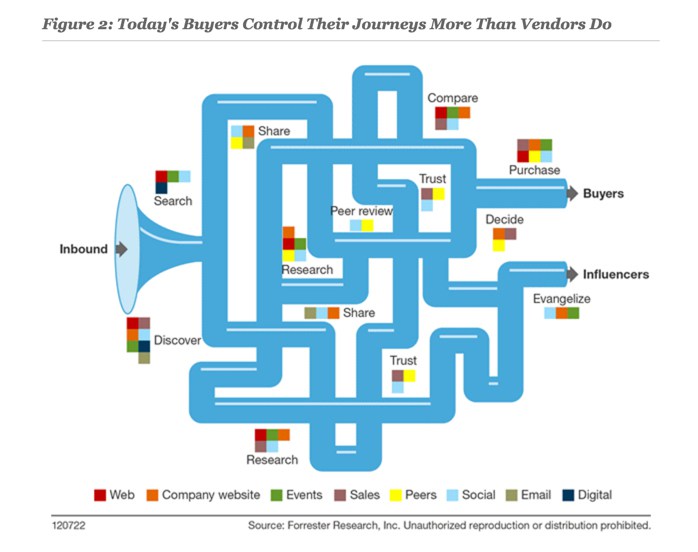The customer journey used to be quite clearly-defined. The consumer embarked on a journey with a retailer or supplier comprising various touchpoints, including awareness, engagement and through to purchase.
The goal of the supplier was to engage the customer along that journey, trying to connect up and contribute meaningfully to add value for the consumer. This traditional journey was generally very linear. First the consumer realized they had a problem and needed a solution, called the Awareness Stage. They then researched some potential solutions, known as the Consideration Stage. Finally, having narrowed down their options to one or two solutions, they sought the best place to buy them, called the Decision Stage. It was a straight funnel down which pretty much all consumers went.
This journey has now changed, thanks to technology. Digital transformation has disrupted the traditional journey and seen it evolve into the ‘customer experience’. Today’s consumers are on more fragmented journey instead of a linear path, and they now have the opportunity to interact with brands and companies directly, send messages via Facebook, participate in online contests and share their interests and reviews of products on social media. They’re now bombarded with advertisements and messaging from multiple channels and platforms rather than just a couple. As such, they are generally better-informed and more aware of products and services.
The merging of physical and digital
Traditional customer journey touchpoints still apply of course. These include marketing channels like direct postal mail and telephone calls, while order fulfilment, a key element of ensuring good customer satisfaction, still has physical form in delivery and returns for example.
At the same time however, indirect touchpoints have been created by technological development. New marketing channels are emerging all the time. Email, social media sites like Facebook, Twitter and Instagram, blogs, consumer chat forums, online product reviews from peers and more have all joined websites as important parts of the customer experience mix. Companies must also think mobile-first, since for many consumers today their mobile is their ‘first screen’.
All of the above touchpoints help the customer in the awareness stage and assist in promoting a brand, and generally help the buyer in their decision-making process – so companies need to pay them due attention. Shoppers are now doing their shopping in a different way, and that has changed the way companies must think about and interact with customers. It is no longer enough to work in terms of the classic funnel, where the consumer was presented with a narrowing range of decisions and choices up until they bought a product – that method paid little attention to the post-purchase experience. Today’s omnichannel consumer expects a continuing engagement after they have bought.
The customer experience map
The funnel in the customer experience era is a much more intricate affair. A few years ago Forrester mapped it out in the below image, and that still holds largely true today. Companies need to take a step back, broaden their scope and be prepared to follow and engage with customers in numerous directions and at multiple, ongoing touchpoints to deliver the best customer experience.

The Forrester map demonstrates the level of interactivity and crossover that now takes place within the customer experience. Companies that develop customer experience maps are those likely to be best placed to accompany customers on that continuous experience and best equipped to engage with them along the way. In 2016 Forrester reported 63 percent of marketing professionals relied on maps to visualize a customer’s whole engagement with their company and the different touchpoints they could use to interact with them.
Those three original stages - Awareness, Consideration and Decision – do still exist within the experience, but consumers now pass through them in a much more non-linear fashion. Buyers might start out searching for a product or service, go through some answers, then change track along the way after acquiring some new information from a different channel. They might communicate with you as they go, and having bought from you, they will certainly expect ongoing after-sales care and support.
So an effective customer experience map must factor in omnichannel communications. Consumers expect this type of integrated, seamless experience across multiple devices and touchpoints, on their terms, and they want a continuing relationship. That way lies loyalty and customer retention; Aberdeen Group reports that companies with the strongest omnichannel customer engagement strategies retain an average of 89 percent of customers, versus 33 percent of companies with poor omnichannel strategies.
Customer experience is now key to acquiring customers and subsequently retaining them. In 2016, Gartner found that 89 percent of businesses considered customer experience to be their key differentiator. The journey is over, now it is all about the experience.
Discover how Orange is helping companies deliver world class customer experience.

I’ve been writing about technology for around 15 years and today focus mainly on all things telecoms - next generation networks, mobile, cloud computing and plenty more. For Futurity Media I am based in the Asia-Pacific region and keep a close eye on all things tech happening in that exciting part of the world.